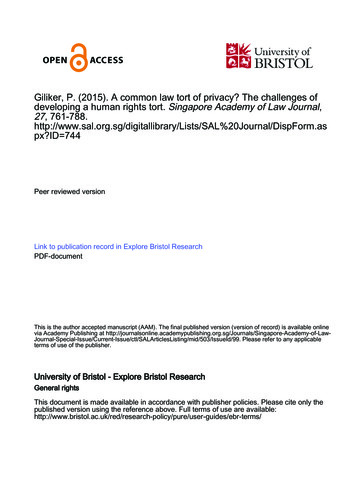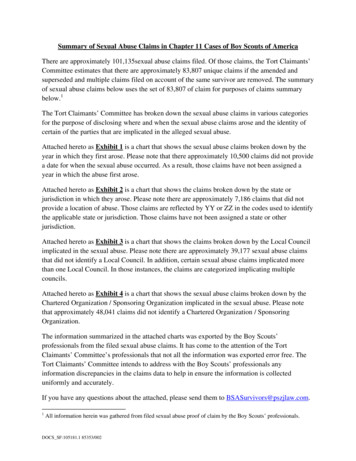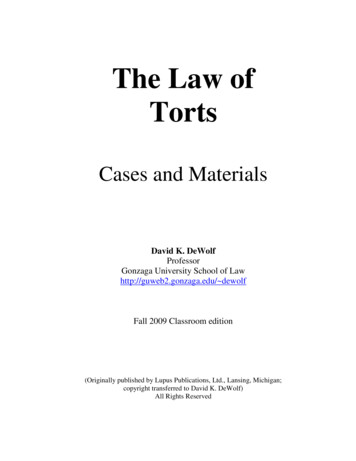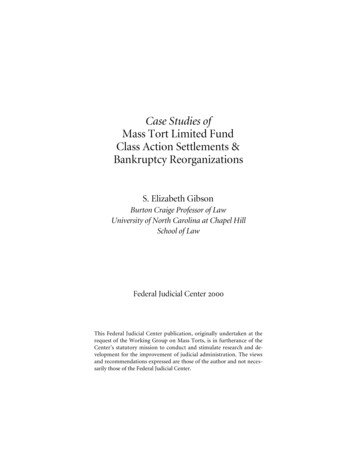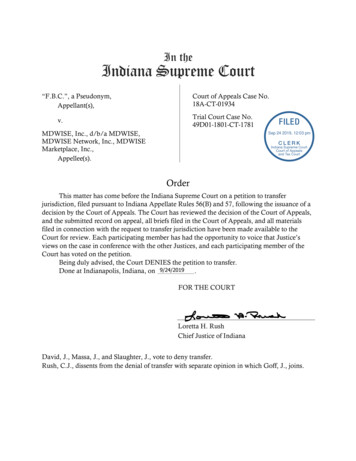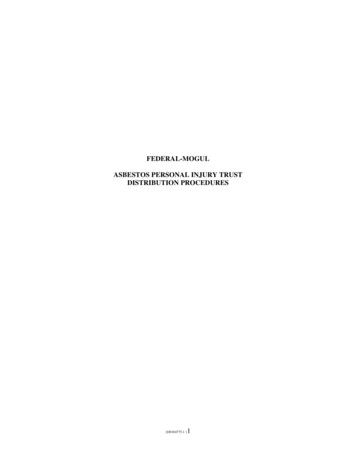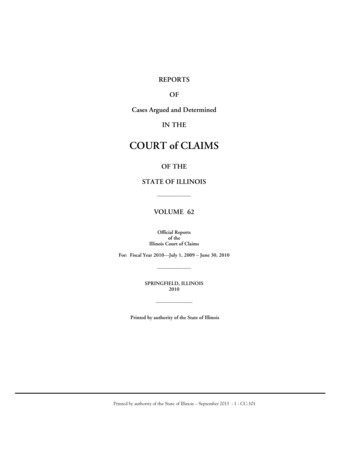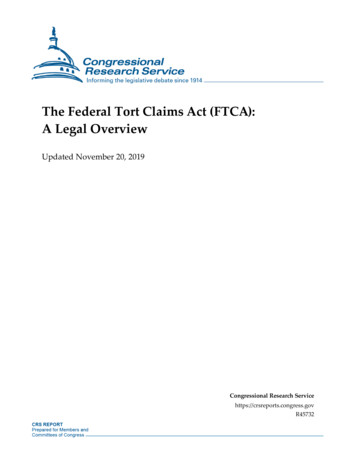
Transcription
The Federal Tort Claims Act (FTCA):A Legal OverviewUpdated November 20, 2019Congressional Research Servicehttps://crsreports.congress.govR45732
SUMMARYThe Federal Tort Claims Act (FTCA):A Legal OverviewA plaintiff injured by a defendant’s wrongful act may file a tort lawsuit to recover money fromthat defendant. To name a particularly familiar example, a person who negligently causes avehicular collision may be liable to the victim of that crash. By forcing people who wrongfullyinjure others to pay money to their victims, the tort system serves at least two functions:(1) deterring people from injuring others and (2) compensating those who are injured.R45732November 20, 2019Kevin M. LewisLegislative AttorneyEmployees and officers of the federal government occasionally commit torts just like other members of the general public.For a substantial portion of this nation’s history, however, plaintiffs injured by the tortious acts of a federal officer oremployee were barred from filing lawsuits against the United States by “sovereign immunity”—a legal doctrine thatordinarily prohibits private citizens from haling a sovereign state into court without its consent. Until the mid-20th century, atort victim could obtain compensation from the United States only by persuading Congress to pass a private billcompensating him for his loss.Congress, deeming this state of affairs unacceptable, enacted the Federal Tort Claims Act (FTCA), which authorizesplaintiffs to obtain compensation from the United States for the torts of its employees. However, subjecting the federalgovernment to tort liability not only creates a financial cost to the United States, it also creates a risk that governmentofficials may inappropriately base their decisions not on socially desirable policy objectives, but rather on the desire toreduce the government’s exposure to monetary damages. In an attempt to mitigate these potential negative effects ofabrogating the government’s immunity from liability and litigation, the FTCA limits the circumstances in which a plaintiffmay pursue a tort lawsuit against the United States. For example, the FTCA contains several exceptions that categorically barplaintiffs from recovering tort damages in certain categories of cases. Federal law also restricts the types and amount ofdamages a victorious plaintiff may recover in an FTCA suit. Additionally, a plaintiff may not initiate an FTCA lawsuit unlesshe has timely complied with a series of procedural requirements, such as providing the government an initial opportunity toevaluate the plaintiff’s claim and decide whether to settle it before the case proceeds to federal court.Since Congress first enacted the FTCA, the federal courts have developed a robust body of judicial precedent interpreting thestatute’s contours. In recent years, however, the Supreme Court has expressed reluctance to reconsider its long-standingFTCA precedents, thereby leaving the task of potentially further developing the FTCA to Congress. Some Members ofCongress have accordingly proposed legislation to modify the FTCA in various respects, such as by broadening thecircumstances in which a plaintiff may hold the United States liable for torts committed by government employees.Congressional Research Service
The Federal Tort Claims Act (FTCA): A Legal OverviewContentsIntroduction . 1Background . 3The Preclusion of Individual Employee Tort Liability Under the FTCA . 7Employees and Independent Contractors . 8The Boyle Rule. 10Scope of Employment .11Attorney General Certification . 13Exceptions to the FTCA’s Waiver of Sovereign Immunity . 16The Discretionary Function Exception . 18Whether the Challenged Conduct Is Discretionary. 19Whether Policy Considerations Influence the Exercise of the Employee’sDiscretion . 22The Intentional Tort Exception. 24The Exception to the Intentional Tort Exception: The Law Enforcement Proviso . 26The Foreign Country Exception . 27The Military Exceptions . 28The Combatant Activities Exception . 28The Feres Doctrine . 29Other Limitations on Damages Under the FTCA . 31Procedural Requirements. 33Legislative Proposals to Amend the FTCA . 36Proposals to Abrogate or Modify Feres . 38Private Bills . 40ContactsAuthor Information. 41Congressional Research Service
The Federal Tort Claims Act (FTCA): A Legal OverviewIntroductionA plaintiff injured by a defendant’s wrongful conduct may file a tort lawsuit to recover moneyfrom that defendant.1 To name an especially familiar example of a tort, “a person who causes acrash by negligently driving a vehicle is generally liable to the victim of that crash.”2 By forcingpeople who wrongfully injure others to pay money to their victims, the tort system serves at leasttwo functions: (1) “deter[ring] people from injuring others” and (2) “compensat[ing] those whoare injured.”3Employees and officers of the federal government occasionally commit torts just like othermembers of the general public.4 Until the mid-20th century, however, the principle of “sovereignimmunity”—a legal doctrine that bars private citizens from suing a sovereign government withoutits consent—prohibited plaintiffs from suing the United States for the tortious actions of federalofficers and employees.5 Thus, for a substantial portion of this nation’s history, persons injured bytorts committed by the federal government’s agents were generally unable to obtain financialcompensation through the judicial system.6Congress, deeming this state of affairs unacceptable, ultimately enacted the Federal Tort ClaimsAct (FTCA) in 1946.7 The FTCA allows plaintiffs to file and prosecute certain types of tortlawsuits against the United States and thereby potentially recover financial compensation fromthe federal government.8 Some FTCA lawsuits are relatively mundane; for instance, a civilianmay sue the United States to obtain compensation for injuries sustained as a result of minoraccidents on federal property.9 Other FTCA cases, however, involve grave allegations ofgovernment misfeasance. For example, after naval officers allegedly sexually assaulted severalSee, e.g., Tort, BLACK’S LAW DICTIONARY (10th ed. 2014) (defining “tort” as “a civil wrong, other than breach ofcontract, for which a remedy may be obtained, usu[ally] in the form of [monetary] damages”). See generally CRS InFocus IF11291, Introduction to Tort Law, by Kevin M. Lewis (describing tort law, its purposes, and its relevance toCongress).2 Bryant Walker Smith, Automated Driving and Product Liability, 2017 MICH. ST. L. REV. 1, 66. See also JeffreyAxelrad, Federal Tort Claims Act Administrative Claims: Better Than Third-Party ADR For Resolving Federal TortClaims, 52 ADMIN. L. REV. 1331, 1332 (2000) (describing “an automobile accident” as a “paradigm” example of a tort).3 E.g., Alberto Galasso & Hong Luo, Tort Reform and Innovation, 60 J.L. & ECON. 385, 386 (2017). See also John C.P. Goldberg, Twentieth-Century Tort Theory, 91 GEO. L.J. 513, 514–83 (2003) (discussing various scholarly accountsof the purposes of tort law).4 See, e.g., Limone v. United States, 579 F.3d 79, 83 (1st Cir. 2009) (affirming district court’s determination thatseveral Federal Bureau of Investigation (FBI) agents committed various torts).5 E.g., Paul Figley, Ethical Intersections & The Federal Tort Claims Act: An Approach for Government Attorneys, 8 U.ST. THOMAS L.J. 347, 348–49 (2011) [hereinafter Figley, Ethical Intersections] (explaining that “[f]or a century and ahalf, . . . the United States’ sovereign immunity . . . protected it from suit[s]” filed by “citizens injured by the torts offederal employees”).6 Axelrad, supra note 2, at 1332 (“Until the Federal Tort Claims Act was enacted in 1946, no general remedy existedfor torts committed by federal agency employees.”). See also Figley, Ethical Intersections, supra note 5, at 348(explaining that, until 1946, “the only practical recourse for citizens injured by the torts of federal employees was toask Congress to enact private legislation affording them relief”).7 28 U.S.C. §§ 1346(b), 2671–80. See also, e.g., id. §§ 2401(b), 2402 (additional provisions of the U.S. Code that applyin FTCA cases). See also infra “Background” (describing the circumstances leading to the FTCA’s enactment in 1946).8 See, e.g., 28 U.S.C. § 2674 (“The United States shall be liable, respecting the provisions of this title relating to tortclaims, in the same manner and to the same extent as a private individual under like circumstances.”).9 See, e.g., Gibson v. United States, 809 F.3d 807, 809–10 (5th Cir. 2016) (lawsuit seeking compensation for injuriesthe plaintiff allegedly sustained as a result of falling off a stepladder while exiting a trailer owned by the FederalEmergency Management Agency).1Congressional Research Service1
The Federal Tort Claims Act (FTCA): A Legal Overviewwomen at the infamous Tailhook Convention in 1991, those women invoked the FTCA in anattempt to hold the United States liable for those officers’ attacks.10 Family members of personskilled in the 1993 fire at the Branch Davidian compound in Waco likewise sued the United Statesunder the FTCA, asserting that federal law enforcement agents committed negligent acts thatresulted in the deaths of their relatives.11 Additionally, the U.S. Court of Appeals for the FirstCircuit12 affirmed an award of over 100 million against the United States in an FTCA casealleging that the Federal Bureau of Investigation (FBI) committed “egregious governmentmisconduct” resulting in the wrongful incarceration of several men who were falsely accused ofparticipating in a grisly gangland slaying.13Empowering plaintiffs to sue the United States can ensure that persons injured by federalemployees receive compensation and justice. However, waiving the government’s immunity fromtort litigation comes at a significant cost: the U.S. Department of the Treasury’s Bureau of theFiscal Service (Bureau) reports that the United States spends hundreds of millions of dollarsannually to pay tort claims under the FTCA,14 and the Department of Justice reports that ithandles thousands of tort claims filed against the United States each year.15 Moreover, exposingthe United States to tort liability arguably creates a risk that government officials mayinappropriately base their decisions “not on the relevant and applicable policy objectives thatshould be governing the execution of their authority,” but rather on a desire to reduce thegovernment’s “possible exposure to substantial civil liability.”16As explained in greater detail below, the FTCA attempts to balance these competingconsiderations by limiting the circumstances in which a plaintiff may successfully obtain adamages award against the United States.17 For example, the FTCA categorically bars plaintiffsHallett v. United States, 877 F. Supp. 1423, 1425 (D. Nev. 1995). The court ultimately dismissed the plaintiffs’claims against the United States on a variety of grounds. See id. at 1427–32; Hallett v. United States, 850 F. Supp. 874,877–83 (D. Nev. 1994).11 See Andrade v. Chojnacki, 65 F. Supp. 2d 431, 441, 446 (W.D. Tex. 1999). The United States ultimately prevailed attrial and on appeal. See Andrade v. Chojnacki, 338 F.3d 448, 453 (5th Cir. 2003).12 This report periodically references decisions by federal appellate courts of various regional circuits. For purposes ofbrevity, references to a particular circuit in the body of this report (e.g., the First Circuit) refer to the U.S. Court ofAppeals for that particular circuit.13 See Limone v. United States, 579 F.3d 79, 83–84, 102, 108 (1st Cir. 2009). See also Bravo v. United States, 583 F.3d1297, 1299 n.2 (11th Cir. 2009) (Carnes, J., concurring in the denial of rehearing en banc) (opining that “[t]he facts inthe Limone case grew out of one of the darkest chapters in the history of the FBI, which involved rampant misconductand corruption in the Boston office spanning a period of at least two decades”).14 The Bureau’s Annual Report to Congress for Fiscal Year 2018, port-congress.html, lists all payments that the United States made to individual claimants under the FTCA and othercompensatory statutes between October 1, 2017, and September 30, 2018. The sum of the “Confirmed PaymentAmounts” for all reported “Litigative Payments” and “Administrative Payments” pursuant to the FTCA equaled a totalof 318,912,807.83. This value includes only those payments that the Bureau explicitly coded as “Federal Tort ClaimsAct” payments.15 Table 5 of the United States Attorneys’ Annual Statistical 336/download, reports that plaintiffs filed 3,009 tort cases against theUnited States during FY2018, and that an additional 4,211 tort cases against the federal government remained pendingfrom the previous year. In addition, the report states that the Department of Justice received 3,051 new tort-related civilmatters during FY2018.16 Mark C. Niles, “Nothing But Mischief”: The Federal Tort Claims Act and the Scope of Discretionary Immunity, 54ADMIN. L. REV. 1275, 1309 (2002).17 See Gregory C. Sisk, Official Wrongdoing and the Civil Liability of the Federal Government and Officers, 8 U. ST.THOMAS L.J. 295, 322 (2011) (“The claim for individual justice in court to an aggrieved person or entity must bebalanced against the common good advanced by effective collective measures of government and the preservation ofdemocratic rule.”); David W. Fuller, Intentional Torts and Other Exceptions to the Federal Tort Claims Act, 8 U. ST.10Congressional Research Service2
The Federal Tort Claims Act (FTCA): A Legal Overviewfrom pursuing certain types of tort lawsuits against the United States.18 The FTCA also restrictsthe types and amount of monetary damages that a plaintiff may recover against the UnitedStates.19 Additionally, the FTCA requires plaintiffs to comply with an array of proceduralrequirements before filing suit.20This report provides an overview of the FTCA.21 It first discusses the events and policy concernsthat led Congress to enact the FTCA, including the background principle of sovereignimmunity.22 The report then explains the effect, scope, and operation of the FTCA’s waiver of theUnited States’ immunity from certain types of tort claims.23 In doing so, the report describescategorical exceptions to the government’s waiver of sovereign immunity,24 statutory limitationson a plaintiff’s ability to recover monetary damages under the FTCA,25 and the procedures thatgovern tort claims against the United States.26 The report concludes by discussing variouslegislative proposals to amend the FTCA.27BackgroundA person injured by the tortious activity of a federal employee generally has two potential targetsthat he might name as a defendant in a tort lawsuit: (1) the federal employee who committed thetort and (2) the federal government itself.28 In many cases, however, suing the employee is not aviable option.29 For one, as explained in greater detail below, Congress has opted to shield federalofficers and employees from personal liability for torts committed within the scope of theiremployment.30 Even if Congress had not decided to insulate federal employees from tort liability,suing an individual is typically an unattractive option for litigants, as individual defendants maylack the financial resources to satisfy an award of monetary damages.31THOMAS L.J. 375, 377 (2011) (“While a concern for fairness and equity in favor of aggrieved plaintiffs certainlymotivated legislators, that concern had to be balanced against others and was not the only impetus behind the FTCA.”);Niles, supra note 16, at 1296 (“The critical objective in providing for governmental exposure to tort liability is arrivingat the proper balance between positive disincentives for negligent and unreasonable activity on the one hand andnegative liability threats which distort the proper decision making process on the other.”).18 See infra “Exceptions to the FTCA’s Waiver of Sovereign Immunity.”19 See infra “Other Limitations on Damages.”20 See infra “Procedural Requirements.”21 This report is not intended to provide an exhaustive treatment of all topics related to the FTCA. Treatises that analyzethe FTCA in greater depth include LESTER S. JAYSON & HON. ROBERT C. LONGSTRETH, HANDLING TORT CLAIMS:ADMINISTRATIVE AND JUDICIAL REMEDIES (2005) and GREGORY C. SISK, LITIGATION WITH THE FEDERAL GOVERNMENT:CASES AND MATERIALS (Foundation Press, 2d ed. 2008).22 See infra “Background.”23 See infra id.; “The Preclusion of Individual Employee Tort Liability Under the FTCA.”24 See infra “Exceptions to the FTCA’s Waiver of Sovereign Immunity.”25 See infra “Other Limitations on Damages.”26 See infra “Procedural Requirements.”27 See infra “Legislative Proposals to Amend the FTCA.”28 See Harbury v. Hayden, 522 F.3d 413, 417 (D.C. Cir. 2008).29 See id.30 See infra “The Preclusion of Individual Employee Tort Liability Under the FTCA.”31 See, e.g., Stephen G. Gilles, The Judgment-Proof Society, 63 WASH. & LEE L. REV. 603, 606 (2006) (“[W]hen itcomes to larger, litigable [tort] claims, many Americans are ‘judgment-proof’: They lack sufficient assets (or sufficientcollectible assets) to pay the judgment in full (or even in substantial part).”); Harbury, 522 F.3d at 417 (describing“federal employee[s]” as “potentially judgment-proof”).Congressional Research Service3
The Federal Tort Claims Act (FTCA): A Legal OverviewFor many litigants, the legal and practical unavailability of tort claims against federal employeesmakes suing the United States a more attractive option.32 Whereas a private defendant may lackthe financial resources to satisfy a judgment rendered against him, the United States possessessufficient financial resources to pay virtually any judgment that a court might enter against it.33A plaintiff suing the United States, however, may nonetheless encounter significant obstacles.34 Inaccordance with a long-standing legal doctrine known as “sovereign immunity,” a private plaintiffordinarily may not file a lawsuit against a sovereign entity—including the federal government—unless that sovereign consents.35 For a substantial portion of this nation’s history, the doctrine ofsovereign immunity barred citizens injured by the torts of a federal officer or employee frominitiating or prosecuting a lawsuit against the United States.36 Until 1946, “the only practicalrecourse for citizens injured by the torts of federal employees was to ask Congress to enactprivate legislation affording them relief”37 through “private bills.”38Some, however, criticized the public bill system.39 Not only did private bills impose “a substantialburden on the time and attention of Congress,”40 some members of the public becameincreasingly concerned “that the private bill system was unjust and wrought with politicalfavoritism.”41 Thus, in 1946, Congress enacted the FTCA,42 which effectuated “a limited waiver32See Harbury, 522 F.3d at 417.See Figley, Ethical Intersections, supra note 5, at 361 (“From the perspective of a plaintiff . . . for whom the FTCAprovides a remedy, the government is the very best sort of deep pocket defendant.”); Axelrad, supra note 2, at 1333(describing the United States as “the ultimate ‘deep pocket’”); Richard H. Seamon, Causation and the DiscretionaryFunction Exception to the Federal Tort Claims Act, 30 U.C. DAVIS L. REV. 691, 739 (1997) (“There is no defendantwith a deeper pocket than the United States.”). To that end, Congress has created a standing appropriation from whichsuccessful claimants may collect FTCA judgments and settlements known as the “Judgment Fund.” 31 U.S.C. § 1304.See also James E. Pfander & Neil Aggarwal, Bivens, the Judgment Bar, and the Perils of Dynamic Textualism, 8 U. ST.THOMAS L.J. 417, 426–27 & nn.51–52 (describing the Judgment Fund and its history); Figley, Ethical Intersections,supra note 5, at 352–54 (same).34 See Harbury, 522 F.3d at 417.35 E.g., Pornomo v. United States, 814 F.3d 681, 687 (4th Cir. 2016) (“The default position is that the federalgovernment is immune to suit.”); Lipsey v. United States, 879 F.3d 249, 253 (7th Cir. 2018) (“The United States assovereign is immune from suit unless it has consented to be sued.”); Evans v. United States, 876 F.3d 375, 380 (1st Cir.2017), cert. denied, 139 S. Ct. 81 (2018) (“The United States is immune from suit without its consent.”).36 Figley, Ethical Intersections, supra note 5, at 348–49 (explaining that, “for a century and a half, . . . the UnitedStates’ sovereign immunity . . . protected it from suit” against “citizens injured by the torts of federal employees”).37 Id. at 348. See also Axelrad, supra note 2, at 1332 (“Until the [FTCA] was enacted in 1946, no general remedyexisted for torts committed by federal agency employees.”).38 See, e.g., Gray v. Bell, 712 F.2d 490, 506 (D.C. Cir. 1983).39 Figley, Ethical Intersections, supra note 5, at 350 (claiming that “Members of Congress had long recognized that”private bills were “a poor way to resolve private claims against the government”).40 Id. See also Helen Hershkoff, Early Warnings, Thirteenth Chimes: Dismissed Federal-Tort Suits, PublicAccountability, and Congressional Oversight, 2015 MICH. ST. L. REV. 183, 187 (describing the significant burdens of“investigating the thousands of tort claims submitted to [Congress] each year for payment and enacting legislation forany claimant Congress chose to compensate”).41 Stephen L. Nelson, The King’s Wrongs and the Federal District Courts: Understanding the Discretionary FunctionException to the Federal Tort Claims Act, 51 S. TEX. L. REV. 259, 267 (2009). See also Axelrad, supra note 2, at 1332(“Favoritism in Congress . . . could make or break the claimant’s ability to be made whole.”).42 See, e.g., Nelson, supra note 41, at 268–71 (discussing the FTCA’s legislative history).33Congressional Research Service4
The Federal Tort Claims Act (FTCA): A Legal Overviewof [the federal government’s] sovereign immunity”43 from certain common law44 tort claims.45With certain exceptions and caveats discussed throughout this report, the FTCA authorizesplaintiffs to bring civil lawsuits1.2.3.4.5.6.against the United States;for money damages;for injury to or loss of property, or personal injury or death;caused by a federal employee’s46 negligent or wrongful act or omission;while acting within the scope of his office or employment;under circumstances where the United States, if a private person, would be liableto the plaintiff in accordance with the law of the place where the act or omissionoccurred.47Thus, not only does the FTCA “free Congress from the burden of passing on petitions for privaterelief”48 by “transfer[ring] responsibility for deciding disputed tort claims from Congress to thecourts,”49 it also creates a mechanism to compensate victims of governmental wrongdoing.50 Inaddition to this compensatory purpose, the FTCA also aims to “deter tortious conduct by federal43E.g., Evans v. United States, 876 F.3d 375, 380 (1st Cir. 2017), cert. denied, 139 S. Ct. 81 (2018).Notably, however, “the United States . . . has not rendered itself liable under [the FTCA] for constitutional tortclaims.” FDIC v. Meyer, 510 U.S. 471, 478 (1994) (emphasis added). See also Dianne Rosky, Respondeat Inferior:Determining the United States’ Liability for the Intentional Torts of Federal Law Enforcement Officials, 36 U.C. DAVISL. REV. 895, 942 n.166 (2003) (“Repeated subsequent attempts to pass legislation creating federal liability forconstitutional torts have failed.”). As a general matter, “federal constitutional claims for damages are cognizable onlyunder” the Supreme Court’s decision in Bivens v. Six Unknown Named Agents of Federal Bureau of Narcotics, 403U.S. 388 (1971), “which runs against individual governmental officers personally,” Loumiet v. United States, 828 F.3d935, 945 (D.C. Cir. 2016), or under the Tucker Act, which waives the government’s immunity against certain types ofconstitutional claims under specified conditions. See, e.g., Paret-Ruiz v. United States, 827 F.3d 167, 176 (1st Cir.2016) (citing 28 U.S.C. § 1491(a)(1)). Nevertheless—and as explained below—even though constitutional tort claimsare not themselves actionable under the FTCA, whether a government employee transgressed constitutional boundswhile performing his duties may nonetheless inform whether an exception to the FTCA’s general waiver of sovereignimmunity bars a plaintiff’s nonconstitutional tort claim. See infra notes 193–198 and accompanying text.45 In addition to the FTCA, other federal statutes may also allow persons to obtain compensation from the United Statesfor injuries or property damage caused by an individual acting on the United States’s behalf. See, e.g., 10 U.S.C.§ 2733(a) (allowing the armed forces to “settle[] and pay” certain “claim[s] against the United States for” property loss,personal injury, or death caused by an officer or employee of the armed forces); id. § 2734(a) (allowing the armedforces to “settle and pay” certain “claim[s] against the United States” brought by an “inhabitant of a foreign country”for property loss, personal injury, or death). See generally Lt. Cmdr. Clyde A. Haig, Discretionary Activities of FederalAgents Vis-A-Vis the Federal Tort Claims Act and the Military Claims Act: Are Discretionary Activities Protected atthe Administrative Adjudication Level, and to What Extent Should They Be Protected?, 183 MIL. L. REV. 110, 110–50(2005) (comparing 10 U.S.C. § 2733(a) to the FTCA).46 See infra “Employees and Independent Contractors.”47 Meyer, 510 U.S. at 477 (quoting 28 U.S.C. § 1346(b)).48 Pfander & Aggarwal, supra note 33, at 424. See also, e.g., Gray v. Bell, 712 F.2d 490, 506 (D.C. Cir. 1983) (notingthat Congress enacted the FTCA “in the interest of providing a more efficient means of compensation” than “securingrecompense by private bill”).49 Figley, Ethical Intersections, supra note 5, at 347. See also Hershkoff, supra note 40, at 196 (explaining that theFTCA “by design shifted responsibility for disputes about government negligence from Congress to the Article IIIcourts”).50 Pfander & Aggarwal, supra note 33, at 424. See also, e.g., Sutton v. United States, 819 F.2d 1289, 1292 (5th Cir.1987) (explaining that Congress enacted the FTCA “to afford easy and simple access to the federal courts for personsinjured by the activities of government” (quoting Collins v. United States, 783 F.2d 1225, 1233 (5th Cir. 1986) (Brown,J., concurring))).44Congressional Research Service5
The Federal Tort Claims Act (FTCA): A Legal Overviewpersonnel” by rendering the United States liable for the torts of its agents, thereby incentivizingthe government to carefully supervise its employees.51The FTCA does not itself create a new federal cause of action against the United States; rather,the FTCA waives the United States’s sovereign immunity from certain types of claims that existunder state tort law.52 Thus, in most respects, “the substantive law of the state where the tortoccurred determines the liability of the United States” in an FTCA case.53 In this way, the FTCAlargely “renders the Government liable in tort as a private individual would be under likecircumstances.”54Critically, however, “although the FTCA’s waiver of sovereign immunity is significant andextensive, it is not complete.”55 To address “concerns . . . about the integrity and solvency of thepublic fisc and the impact that extensive litigation might have on the ability of governmentofficials to focus on and perform their other duties,” the FTCA affords the United States“important protections and benefits . . . not enjoyed by other tort defendants”56 that are explainedextensively below.57 Moreover, to limit the fora in which a plaintiff may permissibly litigate a tortsuit against the United States, Congress
Congressional Research Service SUMMARY The Federal Tort Claims Act (FTCA): A Legal Overview A plaintiff injured by a defendant's wrongful act may file a tort lawsuit to recover money from

